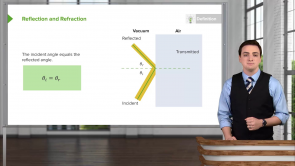Polarization

About the Lecture
The lecture Polarization by Jared Rovny, PhD is from the course Light: Electromagnetic Radiation.
Included Quiz Questions
Which of the following best defines the concept of polarization of electromagnetic waves?
- A property of electromagnetic waves that specifies the geometrical orientation of the oscillations of the electric and magnetic components
- The sum of electric and magnetic field components of electromagnetic waves is called polarization
- Polarization refers to linear and circular polarization of electromagnetic waves
- The relative geometrical orientation of the electric and magnetic components of electromagnetic waves is called polarization
- The direction of propagation of electromagnetic waves is called polarization
How can circularly polarized light be constructed out of linear polarizations?
- Circular polarization can be constructed out of two perpendicular linear polarizations of the same amplitude and wavelength that are out of phase by exactly 90 degrees
- Circular polarization can be constructed out of two parallel linear polarizations of the same amplitude and wavelength that are out of phase by exactly 90 degrees
- Circular polarization can be constructed out of two perpendicular linear polarizations of the same amplitude but one having twice the wavelength of the other one
- Circular polarization can be constructed out of three linear polarizations of the same amplitude and wavelength that make an angle of 120 degrees with each other and are out of phase by 120 degrees
- Circular polarization can be constructed out of two perpendicular linear polarizations of the same amplitude and wavelength that are out of phase by exactly 60 degrees
How can unpolarized light be transformed to a linearly polarized light?
- By sending the unpolarized light through a medium or filter which absorbs the components of the electric field perpendicular to the polarization direction
- By sending the unpolarized light through a medium which amplifies the electric field component of the wave
- By sending the unpolarized light through a glass
- By sending the unpolarized light through a medium or filter which absorbs all the components of the electric field
- By sending the unpolarized light through a medium or filter such that it shifts one component of the electric field by 90 degrees
When a horizontally polarized light comes towards a driver how can the light be blocked?
- By using a vertically polarized filter or glasses
- By using a horizontally polarized filter or glasses
- It will be blocked by the glass in front of the driver
- Any normal glasses will be able to block the polarized light
- Using a circularly polarized filter or glasses
These courses may be of interest to you
Customer reviews
5,0 of 5 stars
| 5 Stars |
|
5 |
| 4 Stars |
|
0 |
| 3 Stars |
|
0 |
| 2 Stars |
|
0 |
| 1 Star |
|
0 |







